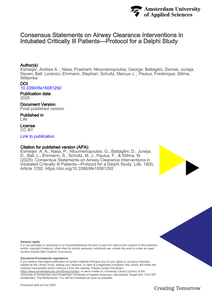Intubated critically ill patients are susceptible to secretion accumulation because of compromised airway clearance. Various airway clearance interventions are employed to prevent complications arising from mucus retention. This Delphi study aims to collect global opinions in an international expert panel of ICU professionals on the usefulness of these various airway clearance interventions. A steering committee performed a literature search informing the formulation of statements. Statements are grouped into two distinct parts: (1) Humidification and Nebulization, and (2) Suctioning and Mucus mobilization techniques. For each part, a diverse panel of 30–40 experts will be selected, with concerted effort to involve experts from various medical specialties involved in airway clearance methods. Multiple choice questions (MCQs) or 7-point Likert-scale statements will be used in the iterative Delphi rounds to reach consensus on various airway clearance interventions. Rounds will continue until stability is achieved for all statements. Consensus will be deemed achieved when a choice in MCQs or a Likert-scale statement achieves ≥75% agreement or disagreement. Starting from the second round of the Delphi process, stability will be assessed using non-parametric χ2 tests or Kruskal–Wallis tests. Stability will be defined by a p-value of ≥0.05.
DOCUMENT

Background: Airway care interventions and prone positioning are used in critically ill patients with coronavirus disease 2019 (COVID-19) admitted to the intensive care unit (ICU) to improve oxygenation and facilitate mucus removal. At the onset of the COVID-19 pandemic, the decision-making process regarding the practice of airway care interventions and prone positioning was challenging. Objective: To provide an overview of the practice of airway care interventions and prone positioning during the second wave of the pandemic in the Netherlands. Method: Web-based survey design. Seventy ICU nurses, each representing one intensive care in the Netherlands, were contacted for participation. Potential items were generated based on a literature search and formulated by a multidisciplinary team. Questions were pilot tested for face and construct validity by four intensive care nurses from four different hospitals. Results: The response rate was 53/77 (69%). This survey revealed widespread use of airway care interventions in the Netherlands in COVID-19 patients, despite questionable benefits. Additionally, prone positioning was used in invasively and non-invasively ventilated patients. Conclusions: The use of airway care interventions and prone positioning is time consuming and comes with the production of waste. Further research is needed to assess the effectiveness, workload, and environmental impact of airway care interventions and prone positioning.
DOCUMENT

INTRODUCTION: Mechanical Insufflation-Exsufflation (MI-E) is used as an airway clearance intervention in primary care (home ventilation), long-term care (prolonged rehabilitation after intensive care, neuromuscular diseases, and spinal cord injury), and increasingly in acute care in intensive care units (ICU).AIM: We sought to develop in-depth understanding of factors influencing decision-making processes of health care professionals regarding initiation, escalation, de-escalation, and discontinuation of MI-E for invasively ventilated patients including perceived barriers and facilitators to use.METHODS: We conducted focus groups (3 in the Netherlands; 1 with participants from four European countries) with clinicians representing the ICU interprofessional team and with variable experience of MI-E. The semi-structured interview guide was informed by the Theoretical Domains Framework (TDF). Two researchers independently coded data for directed content analysis using codes developed from the TDF.RESULTS: A purposive sample of 35 health care professionals participated. Experience varied from infrequent to several years of frequent MI-E use in different patient populations. We identified four main themes: (1) knowledge; (2) beliefs; (3) clinical decision-making; and (4) future adoption.CONCLUSION: Interprofessional knowledge and expertise of MI-E in invasively ventilated patients is limited due to minimal available evidence and adoption. Participants believed MI-E a potentially useful intervention for airway clearance and inclusion in weaning protocols when more evidence is available.RELEVANCE TO CLINICAL PRACTICE: This focus group study provides an overview of current practice, knowledge and expertise, and barriers and facilitators to using MI-E in mechanically ventilated patients. From these data, it is evident there is a need to develop further clinical expertise and evidence of efficacy to further understand the role of MI-E as an airway clearance technique for ventilated patients.
DOCUMENT
